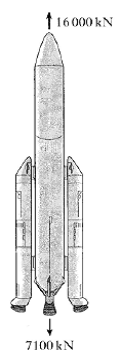 1. A spacecraft consisting of a rocket and a lunar probe is launched from the Earth to the Moon.
1. A spacecraft consisting of a rocket and a lunar probe is launched from the Earth to the Moon.
(a) At lift-off from the Earth, the spacecraft has a weight of 7100 kN. The thrust from the engines is 16000 kN.
(i) Calculate the unbalanced force acting on the spacecraft.
(ii) Find the mass of the spacecraft.
(iii) Calculate the initial acceleration.
2. Cosmologists use “light years” as a unit of distance.
(a) Calculate the number of metres in 1 light year.
(b) The Leo A Galaxy is 2.25 million light years from the Earth.
Calculate this distance in metres.
3. The nearest star to our solar system is Proxima Centauri which is 3·99 x1016 m away. How far is this in light years?
4. The Sun is the nearest star to the planet Earth. It takes light 8·3 minutes to reach us from the Sun. Use this information to find out the distance from the Earth to the Sun in kilometres.
5. Sir William Herschel, an amateur astronomer, discovered the planet Uranus in March 1781. Uranus is 2 871 x 106 km away from the sun. How long does it take for sunlight to reach Uranus?
